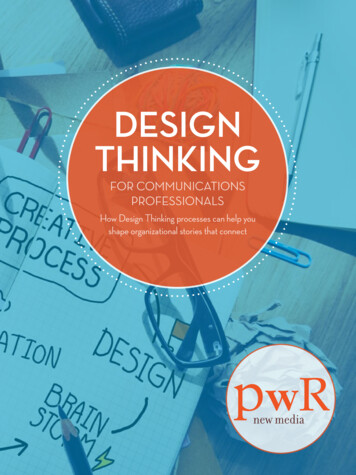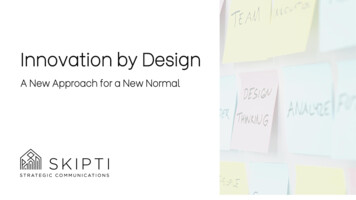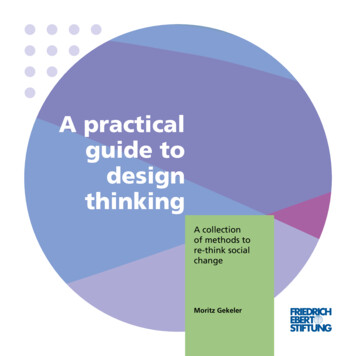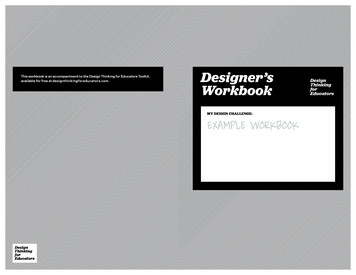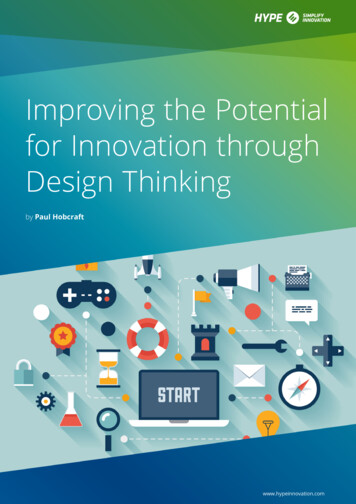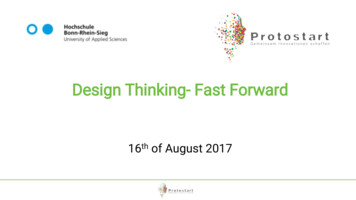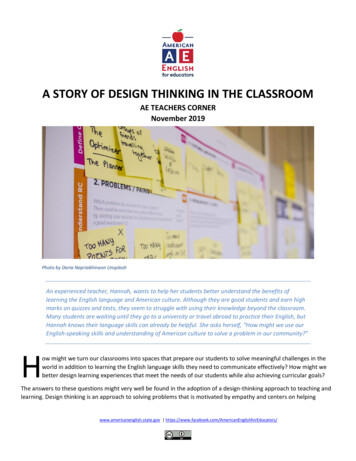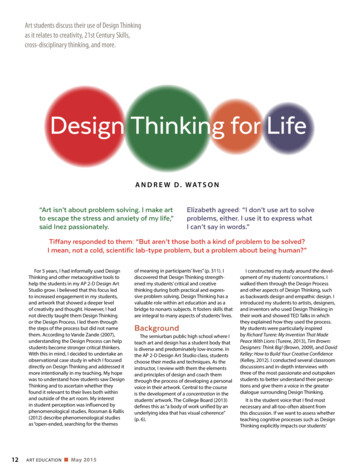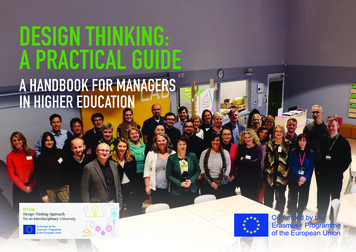
Transcription
DESIGN THINKING:A PRACTICAL GUIDEA HANDBOOK FOR MANAGERSIN HIGHER EDUCATIONCo-funded by theErasmus Programmeof the European Union
2CONTENTINTRODUCTIONSECTION 1: BCU INTERNATIONALWORKSHOP FOR MANAGERS IN HE57SECTION 2: LOCAL WORKSHOPSFOR MANAGERS IN HEUniwersiteit van Amsterdam (UvA)1617Sapienza Università di Roma (Sapienza)20SECTION 4: EXAMPLES OF USINGDESIGN THINKING IN AN HE CONTEXTInternational Cooperation Centre (ICCL),Maria Curie-Sklodowska University (UMCS)3738Talentway Programme, University ofEconomics Bratislava (UEBA)41OBSERVATIONS AND RECOMMENDATIONS44Technische Universität Dresden (TU Dresden) 22GLOSSARY OF DESIGN THINKING TOOLS46Westfalische-Wilhelms University (WWU)25REFERENCES47SECTION 3: LOCAL WORKSHOPSFOR ACADEMICSMaria Curie-Sklodowska University (UMCS)2726BIBLIOGRAPHY48Birmingham City University (BCU)31Appendix i: Typical Challenges InA University Environment50Instituto Politécnico da Guarda (IPG)33Appendix ii: Evaluation Of The BCUInternational Workshop For Managers In HE52University of Economics Bratislava (UEBA)35Appendix iii: Before And After WorkshopQuestionnaire59
PARTNERSDT.Uni.Design Thinking Approachfor an Interdisciplinary UniversityCo-funded by theErasmus Programmeof the European Union
4EDITORS:Kathryn Burns, Birmingham City University, United KingdomCharmaine Stint, Birmingham City University, United KingdomTHANKS:The editors would like to thank all participants of the DT.Uni projectwithout whose time and effort this handbook could not have beenproduced.In particular, we thank Joanna Górka and Olga Pliszczyńska-Mokijewska,International Cooperation Centre, Maria Curie-Sklodowska Universityfor their excellent project management and support; Veronika Nekolová,Barbora Paholková and Anna Veszprémi Sirotková, University ofEconomics in Bratislava, for their help in structuring the handbook andundertaking the comprehensive evaluation of the international workshopin Birmingham; and the following for contributing to workshops andproviding accounts: Maria del Carmen Arau Ribeiro, Pedro Rodrigues,Noel Lopes and Natália Gomes, Instituto Politécnico da Guarda; ClaudiaCarter, Laura Veart, Zuby Ahmed, Alexa Torlo, Steve Harding and TomCahill-Jones, Birmingham City University; André Nusselder, KatushaSol and Natasa Brouwer, Uniwersiteit van Amsterdam; Marino Bonaiuto,Silvia Cataldi, Michele Mazzola and Alessandra Talamo, SapienzaUniversità di Roma; and last, but in no ways least, Christian Bruchatz,Robert Fischer, Peer Kittel, Robert Härer and Martin Meyer, TechnischeUniversität Dresden.Very many thanks to all - Kathryn and CharmainePUBLISHER:ISBN number - 978-1-904839-95-8This project has been co-funded by the Erasmus Programme of the European Union (Project number: 2017-1-PL01-KA203-038527). This publication reflects the viewsonly of the authors. The National Agency and European Commission cannot be held responsible for any use which may be made of the information contained therein.PUBLICATION FREE OF CHARGE.This work is licensed under a Creative CommonsAttribution 4.0 International LicenseDesign by Numero Uno (UK) Ltd - T. 01564 822824, E. numerounoltd@icloud.com
5INTRODUCTIONThe DT.Uni project‘DT.Uni – Design thinking approach for an interdisciplinary university’ ispart-funded by the Erasmus programme. Led by the University Maria CurieSklodowska (UMCS), the project partnership comprises eight institutions:Technische Universität Dresden (TU Dresden), GermanyHáskólinn á Bifröst, IcelandSapienza Università di Roma, ItalyMaria Curie-Sklodowska University (UMCS), Lublin, PolandInstituto Politécnico da Guarda (IPG), Guarda, PortugalUniversity of Economics in Bratislava (UEBA), SlovakiaUniwersiteit van Amsterdam (UvA), The NetherlandsBirmingham City University (BCU), UKDT.Uni’s prime objective is the promulgation of interdisciplinary work inhigher education institutions. It is intended that this is achieved by buildingan appreciation of design thinking methods in three interlinked groups:academics; higher education managers; and students. Project activities includeinternational and local workshops as well as developing workbooks and casestudies relating to the implementation of design thinking in higher education.The project aims to equip the next generation with soft skills such as problemsolving and critical thinking so that they become producers, not consumers,of knowledge. Overall, the project considers that design thinking will enhancethe level of interdisciplinarity among participants by improving their abilities tothink in a divergent, creative and designerly way.For more details see: www.umcs.pl/en/dtuni.htmDT.Uni methodologyDT.Uni’s overall rationale is to ‘train’ people in design thinking tools andtechniques through four-day workshops attended by representatives of theproject partners. Attendees should then take the principles back to theirinstitutions to implement for groups of students, academics and managers.The first international workshop, for academics, was held in Dresden in April2018 and organised by Technische Universität Dresden (TU Dresden). Thesecond, described in this handbook, was held for higher education managers,including administrators as well as academics with managerial responsibilities,at Birmingham City University (BCU) in November 2018.The TU Dresden workshop was organised and delivered by Christian Bruchatz,Robert Fischer and Pierre Herzer, who provided a blueprint for the BCU version.It also resulted in four local multiplier academic workshops at UMCS, IPG,UEBA and BCU, all delivered by TU Dresden attendees. The BCU workshophas led to four sessions for managers at UvA, Sapienza, TU Dresden andWestfalische-Wilhelms University, Münster.For all the workshops, the organisers chose their own format and timetable. Thefollowing describes each session, covering pre-workshop planning, workshoporganisation, the design thinking tools used and tips and recommendations.The handbook also includes examples of the practical implementation of designthinking tools in management and teaching contexts.Overview of design thinking and its benefitsThroughout, design thinking focuses on and is empathetic with the user ofa product or service. Key features include the use of techniques to cultivatedivergent and convergent thinking, such as the generation and filtering of ideas,as well as working in groups to develop solutions.The process starts with a challenge often a complex or ‘wicked’ problem. It isusually couched as a ‘How might we .?’ question. At this stage, the processfocuses on establishing what the challenge is and ensuring the appropriate oneis being addressed. Design thinking then encompasses a number of stages.These vary according to design thinking gurus. The DT.Uni approach comprisesfour stages:explore: build an understanding of the user and their needs as well asunsolved problems;create: design and evaluate potential solutions;prototype: build a physical or virtual model to demonstrate one or moresolutions; andevaluate: test the prototype with users and improve and/or redevelop ideas.
6At each stage different tools are used to achieve the desired outcome. Forexample, we tended to use a form of brainstorming as an idea generator(divergence) and clustering and dot voting to filter ideas (convergence).Key features of design thinking are: a focus on solving wicked or complex problems with an emphasis on theuser; learning by doing, involving a haptic process, for example, writing andmaking; working in groups with no hierarchy; and allowing people to fail so that solutions do not need to be perfect.Design thinking has a large number of benefits and attractions for academics,managers and students. These include: the formation of functional interdisciplinary groups facilitated throughtools such as, brainstorming and brainwriting, which also allow allgroup members to present their ideas; a lack of hierarchy in groups where trust is formed relatively quickly withpeer review allowing ideas to be discussed and assumptions challengedand/or tested in a relatively safe environment; the development of solutions that group members feel that they wouldnot have arrived at individually; and the building of a prototype as a means of hands-on shaping andtesting of ideas as well as a tool to sell the idea through the institution,particularly to senior management.Potential uses of design thinking by higher education managers include: to gain a better understanding of their users, for example, students, toimprove services; identifying new opportunities or solutions; supporting individuals to develop a broad mindset when dealing withcomplex problems; improving teamwork especially in mixed and/or interdisciplinary groups; testing solutions through prototyping using trial and error methods; exercising flexibility and adaptability to a variety of contexts and ideas; developing a variety of soft skills and interpersonal competences suchas listening and communicating; reforming or building teams in uncertain situations; and facilitating organisational change.More details of the design thinking process and descriptions of the tools andtechniques can be found in various publications including Bruchatz et al. (2019),Fraser (2012) and Lewrick et al. (2018).Purpose of this handbookAs above, this practical guide describes a number of workshops held acrossEurope to train fellow workers in design thinking techniques and processes. Itcovers how teams have organised their sessions encompassing the structure,tools chosen, length, workshop delivery and evaluation. Through reflection onthis process we have developed top tips and recommendations for designing,delivering and facilitating sessions.It is very much a practical guide, highlighting the elements that might behelpful for others delivering similar workshops or implementing the methodsin everyday working. The workbook complements other DT.Uni outputs suchas a set of best practice case studies, handbook of tools and database ofteaching activities. These are available from the project website atwww.umcs.pl/en/dtuni.htm.
7SECTION 1:BCU INTERNATIONAL WORKSHOP FORMANAGERS IN HEThis section describes the international workshop for managers held atSTEAMhouse, Birmingham City University, Birmingham, UK from 26 Novemberto 30 November 2018.A key element of the DT.Uni project, the following covers how the BCU teamdevised and delivered the workshop. It reports on the workshop organisation,details of activities for each day and the thoughts of the team soon after itsconclusion. The issues considered in planning and delivering the workshop aswell as the thinking behind structure and content are also included.A formal evaluation of the workshop is provided in Appendix II
8BCU INTERNATIONAL WORKSHOP FORMANAGERSSummary of design thinking tools usedForm and defineIntroduction to design thinkingWorld caféExploreExplain to a strangerPersona mappingFraming the challengeCreateLean caféDesign briefBrainstorm and filteringBrainwritingIdea communication sheetPrototypingEvaluationIntroduction to prototypingPrototypingVideo pitchRefining of prototypesShow and tellIndividual and group reflectionFinal reviewTeamKathryn Burns; Tom Cahill-Jones; Steve Harding; Charmaine Stint; Alexa Torlo additional facilitators: Claudia Carter; Laura VeartParticipantsThe 34 delegates came from DT.Uni’s partner institutions (see Introduction)undertaking a range of management roles, such as, course director, IT orproject manager, dean and principal. Several attendees had run or attended theDresden workshop and, overall, there was a range of design thinking knowledgeand experience from novice to expert.More details of the demographic of the participants is given in the evaluation inAppendix II.Pre workshop organisationAims and considerations: Our main driver in developing content for theworkshop was to build the design thinking knowledge and skills of ourparticipants. We also aimed to: increase understanding of the design thinking process and how it maybe used in daily work; develop an ability to frame challenges, problems or ‘wicked tasks’; cultivate an appreciation of core design thinking elements such asempathy and creative problem solving as well as the value of differentperspectives in establishing solutions; allow participants to network with like-minded people in similar roles indifferent institutions and countries; and provide a fun, useful and informative experience.The workshop was conducted in English, but with participants from acroosEurope. Therefore, we also considered the international nature of theparticipants and the requirement that some (Germany, Iceland, Italy and theNetherlands) would need to run a local multiplier workshop. Overall, we wantedto deliver a hands-on experimental environment where participants were notafraid to make mistakes and could learn by doing.Space: We held the workshop at BCU’s STEAMhouse – a facility designed totackle challenges and foster interdisciplinary working. We used the same roomfor the whole week with plenty of wall space as well as movable boards for theinevitable deluge of sticky notes!Evaluation: Our colleagues from UEBA (Anna Veszprémi Sirotková, BarboraPaholková and Veronika Nekolova) undertook an evaluation through surveysbefore and after the workshop. This is described in full in Appendix II. Thequestionnaire is provided in Appendix III.We also asked participants to reflect on workshop activity and complete a worklog including ‘what have I learnt?’ and ‘what does it mean for me?’ at the endof each day. This was used on the final day of the workshop as part of a reviewsession.Agenda: At an early stage we decided to use the same format as the Dresdenworkshop prioritising: problem/challenge definition; user profiles and journeys;idea generation and filtering; prototype development and evaluation andreflection.
9We chose to have a lead facilitator for each day who took ownership of the toolsand content for their session. Tools and techniques included those felt to beparticularly effective during the Dresden workshop, as well as some from ourown practice and experience. The whole programme also included social visitsand speakers from local projects and organisations. Each session was designedto be people centred as well as allowing participants time to understand andexplore the relevant element of the design thinking process.Group formation and challenges: While organising the workshop, we spentsome time discussing how to set up the groups and the format of the challenges– should we set them in advance or allow participants to choose their own? Weagreed that the challenges should be relevant to participants and the demandson the higher education system. After discussion, we decided to use a WorldCafé to allow participants to work on their own challenges. Therefore, beforetheir arrival in Birmingham, we asked delegates for the top three issues in theirworking life. Common issues are provided in Appendix I. Internationalisation Project and team managementAt the start of Day 2, we allocated the groups based on participants top threepreferences using a challenge ranking template. The aim was to allocateparticipants based on their first preference where possible unless this resultedin a group with too many participants from the same organisation. Groupsstayed together for the rest of the week.Organisation: We allowed around 21 days person time across the team forplanning the workshop, comprising six sessions with usually 3-4 attending.Between sessions, we shared information and preparation of material via aone-drive shared directory.Workshop overviewIn line with the Dresden model, each workshop day focused on a phase of thedesign thinking process. The agenda overview is shown above – the followingdescribes the tools used for each day in more detail.STEAMhouse - workshop locationDay 1: introduction and group formationOur workshop started with a welcome, icebreaker and an introduction todesign thinking. As described above, we wanted the groups to be self-selectingand relevant to members so we held a ‘World Café’ based on pre-submittedchallenges. The challenges were grouped under themes identified as: Management Research Students Human resources AdministrationBCU managers workshop participants
10Day 2: EXPLORE – scope the challengeStarting point: Formation of working groupsIce breaker:Share with your group members one thing you are good at andone thing you consider important in teamworkExplain to astrangerChoose a character from a picture in Birmingham Museumand Art Gallery (visited by participants) to represent thepersona (user) affected by your challenge.PersonamappingFor your chosen persona describe their goals; values;motivation; what they see and hear when they interact withthe challenge; what they think and say to their peers aboutthe challenge; their concerns, what they are happy about andhow they interact with the challenge. This leads to an in-depthunderstanding and appreciation of the challenge.Framing thechallengePlace the challenge at the centre of a workspace mapall connection points (people, places, organisations etc)identifying how each is affected by the issue – leads todeciding ‘How might we .?’.End point:Challenge expressed as ‘How might we ?’Explore - persona journeyExplore - presentationExplore - explain to a strangerExplore - workshop view
11Day 3: CREATE – generate ideas to solve the challengeStarting point‘How might we ?’Lean CaféWith the design brief in mind, write down the topicsyou feel are needed to complete the template. Use ‘do’,‘doing’, ‘done’ to decide, as a group, which topics arerelevant and important.Design briefA single page defining the problem; target customer;goals; available material; competition/alternatives;budget/restrictions; schedule/scenarios; and next steps(answers Why? Who? What? With what? Who else? Howmuch? When? How?) – see picture.The brief may be used to gain support and as well asserving as an agreed basis for what the problem is andhow to go about solving it. (See Lewrick et al. (2018))BrainstormWorking individually for 5 minutes come up with ‘evil’,‘playful’, ‘utopian’ and ‘realistic’ ideas. Use differentcoloured sticky notes for each theme and discuss eachone as a group before moving on to the next. The result– a large number of ideas, some monstrous oroutrageous.Filter thebrainstormAs a group, cluster ideas and identify common themes.Filter according to which are ‘ordinary’, ‘exciting’ or‘impossible’. Use dot voting to choose the ideas forfurther work.BrainwritingEach person chooses three ideas, each written on asticky note. The next person expands the idea and thenpasses it to another person, who does the same. Wheneverybody has contributed ideas are summarised.IdeacommunicationsheetSummarise the most popular idea (from dot voting) or ahybrid on an idea communication sheet – see picture –comprising slogan, problem/need, solution, benefits anda representation of the idea (See Lewrick et al. (2018)).As above, this could be used to gain support for furtherwork. It also forms the basis of the prototyping phase.End pointCompleted idea communication sheet.Create - example design briefCreate - sticky notesCreate - example idea sheet
12Day 4: PROTOTYPE phase: developing responses to the challengesStarting pointIdea Communication sheetIntroductionLed by a prototyping expertWhat is prototyping? How to prototype? Exploration ofprototyping methods and hands-on session – build aphone holder in 5 minutesPrototypingUsing the material available plasticine, lego, coffee cups,sugar stirrers, sweets, paper and pens etc – build aprototype of your solution.Video pitchGuided by the workshop facilitator, each group prepareda short structured video describing its response to thechallenge and the thinking behind its prototype.FinalisingGroups refined prototypes until satisfied with the outcome.End point3D prototypes – see picturesPrototyping - phone holderPrototyping - getting goingPrototyping - presentationPrototyping - pitch shoot
13Day 5: EVALUATE dayWe started the final day with a ‘show and tell’ where each group explained theirthinking and how/why they created their prototype in the way that they did.This moved to a review of the week where participants were asked to sharetheir thoughts on how they felt overall and what they felt worked well and whatworked less well.Participants also completed a template, individually, to establish what theywould focus on in the short, medium and longer term back at their owninstitutions. We thought this would help in identifying how they might use someof their new design thinking and learning.The challenges and solutions developed by the groups during the workshop aregiven in the table below.Evaluation - show and tellPrototypesGroup nameChallengeSolutionFri pm feverHow can we build flexibility into hierarchical decisionmaking?Informal meeting for discussing important issues between managers and teams(includes free beer and an idea collecting mechanism)LifelonglearningHow might we make lifelong learning more motivating, Students identify their own needs and create their own programmes, both locally andvaluable and attractive to students?globallyBettertogetherHow could we improve the quality of communicationbetween academics/ researchers and administration?Collaborative programme to improve understanding and build trust between academicsand administrators based on a series of formal and informal activitiesMay the force How to find the right project role for a person in orderto maximise project potential?A game to help team members to find their roles and understand other perspectivesduring the projectConnectedspacesHow can we embed a sustainable learner-centredapproach in our staff?Promotion of fun, support and excellence through sustainable creative spaces andon-going activities to build a community for learners, staff and local peopleTeam dayHow can we overcome the difficulties universityemployees find in collaborating?A special programme held on a regular basis to encourage collaboration includingsocial events; team building workshops; sports and counsellingPeace andHow can we build an environment to attractlove campus international students?Build a campus with a tolerance based strategy (diversity), cross-cultural events forstudents, mentoring for students and customised study
14Solution - Connected spacesSolution - Better togetherSolution - Team dayThe majority of participants expressed that they very much enjoyed using designthinking and that they found the approach very effective, producing betterand more advanced solutions than they had expected from the workshop or ifworking by themselves or in their normal environment.Group dynamics and engagement with the DT processSolution - Feel the forceSolution - Life long learningSolution - Friday afternoon feverSolution - Peace and loveEvaluationThe following is based on the thoughts of the facilitation team shortly after theworkshop was delivered. The results of the formal evaluation of the workshopby UEBA are presented in Appendix II.Functioning groups are fundamental to using design thinking techniques,whether in a workshop or daily work environment. Our groups had a mix ofparticipants from different institutions as well as members from different levelsand areas of management. We found that some groups took longer to bond, inpart due to personalities and possibly being out of their comfort zone. However,by the end of Day 2 all groups were working well together with good andinterdisciplinary communication and collaborative group dynamics.Also, we observed that although all participants engaged with the different toolssome needed repeated (or improved) explanation. This tended to be differentmethods for different people or groups rather than be uniform across the wholeworkshop. There was also one group that tended to work very quickly – possiblynot fully embracing the ethos of design thinking – and showed a reluctanceto the amount of writing and rewriting of ideas and solutions. While the groupworked together for the week, it may have been more productive to move theminto other groups to develop a more fulfilling experience.In our desire to group people with their first choice of challenge some groupswere only 3 – 4 people. This proved problematic with some tasks especiallywhen one or more group members were absent, for example, late in returningfrom a break or arriving in the morning.
15FacilitationWorkshop lengthWith the benefit of hindsight, we would refine some aspects of facilitation suchas making the time for ‘review and reflect’ at the end of each day. As above,we should have checked understanding of tasks and clarified the iterativeand divergent/convergent nature as well as the current position in the designthinking process. Also, we could have considered the language abilities of ourparticipants more carefully – both verbal and written. Time slots for the tasksand the overall schedule should have been enforced more effectively.It is difficult to get people to commit time away from their workplace and wefound it exacting to achieve the workshop numbers we needed to meet theproject’s requirements. Spending a week of November in Birmingham wasnot overly attractive! As a result, we tried to provide a range of evening socialactivities to attract participants.Many participants had not used design thinking processes before, whereasothers were very experienced. One had run a number of similar workshops ina professional capacity and several others had been involved in the Dresdenworkshop as facilitators or participants.This mixed group made it difficult for us, as the facilitation team, to pitchcontent, gauge the level of instruction required and pace the days effectively.Participants more familiar with the process often completed tasks quickly, notallowing sufficient time for colleagues in their group to process the activitybefore moving on. On the other hand, experienced group members providedadditional support and guidance to those less familiar with design thinking.Tips and recommendations Create a list of priority objectives and create a schedule to meet them. Make the time to plan and organise your workshop effectively. Check that content links from day to day and that you allow time forparticipants to review and reflect – individually, with their groups andbetween groups. Keep in mind that you will have a range of experience, knowledge,abilities and personalities in your workshop or meeting. Try to useactivities to appeal to a range of traits. Where possible, provide instructions in a visual and verbal format,providing an example where appropriate – for examples see the Dresdenworkbook. Encourage your participants to be open minded and be prepared tolisten as well as keeping distractions, such as emails and phone calls, toa minimum. Enjoy it! Though daunting, facilitating a workshop to support people intheir understanding of the value and benefits of design thinking can beextremely rewarding.Content and instructionsAs described above, each facilitator ran a separate day and phase of theworkshop. This meant that planning could be done independently, saving time,but that content may have appeared disjointed. Additionally, facilitators wereonly fully conversant with the activities on their day, so that groups may havereceived diverse interpretations of instructions for specific tasks on other days.This independence also meant that we did not refer to the original problem orcheck back often enough that new materials were still in line with the originalchallenge.Further, we chose to cover a phase of the process each day. Again withhindsight, we could have covered this content in less time and used the last fullday for groups to work with members of their own institutions on a blueprint fora multiplier workshop (if appropriate) and/or how they might use the tools andtechniques in their every day work back at base.
16SECTION 2:LOCAL WORKSHOPS FOR MANAGERS IN HESection 2 comprises four local workshops, following the Birmingham workshop,delivered by project partners and designed for managers in higher education.Uniwersiteit van Amsterdam, Amsterdam, The Netherlands (UvA)Workshop held 20 and 24 May 2019 at UvA and delivered by UvA (with onlineactivities between workshops)Sapienza Università di Roma, Rome, Italy (Sapienza)Workshop held 6 June 2019 at Sapienza and delivered by SapienzaTechnische Universität Dresden, Dresden, Germany (TU Dresden)Workshop held 25 and 26 June 2019 at TU Dresden and delivered by TU DresdenWestfalische-Wilhelms University, Münster, Germany (WWU)Workshop held 25 February 2020 at WWU and delivered by Maria CurieSklodowska University (UMCS)
17UVA MANAGERS WORKSHOPSummary of design thinking tools usedForm and defineIntroduction to design thinkingGet to know your teamChallenges introducedAttendeesNine in total split across University of Amsterdam, Vrije Universiteit Amsterdam,University of Applied Sciences, Amsterdam, Utrecht University and ReflectAcademy covering a range of disciplines and mainly inexperienced in usingdesign thinking.Pre-workshop organisationExploreFirst formulation of challenge - ‘Howmight we.?’Who? What? Why? How?Interview potential userPersona mappingIn preparing and organising our workshop we focused on increasing themotivation of our participants to explore and solve ‘wicked’ problems ineducation policy. We wanted to explore two increasingly popular approaches:interdisciplinary education, particularly in relation to explaining phenomenon,solving problems and/or creating a product, as well as design thinking as amethod of solving problems innovatively.CreateBrainstorming and ideating ‘Howmight we.?’Selection and evaluation of ideasthrough dot votingBrainwriting - done between sessionsPrototypingIntroduction to prototypingChoose idea to prototypeBuild prototypes working in groupsTest prototypesTeams present work throughst
organisation, the design thinking tools used and tips and recommendations. The handbook also includes examples of the practical implementation of design thinking tools in management and teaching contexts. Overview of design thinking and its benefits Throughout, design thinking focuses on
